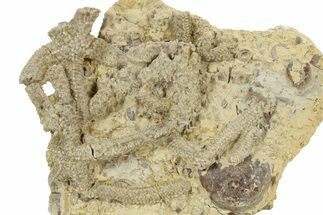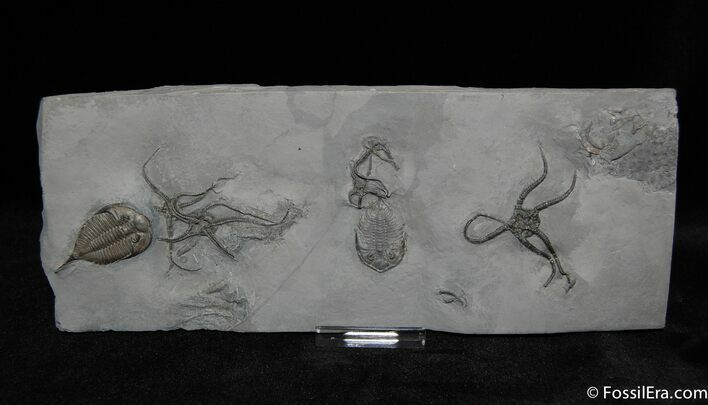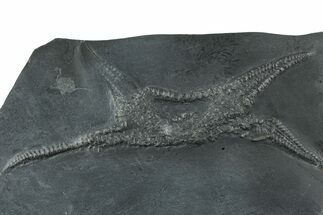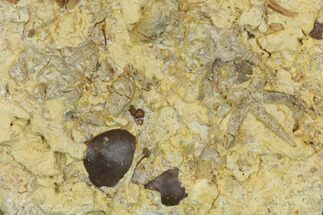This Specimen has been sold.
Amazing Plate - 2 Trilobites and 4 Starfish
Here is a one of a kind and simply amazing association plate from the Rochester Shale of NY. It has includes two Dalmanites limulurus trilobites, FOUR starfish of two different species, as well as a few horn corals. Single starfish from the Rochester shale are fairly rare but to get four of them on a plate with a couple trilobites is something really special indeed. This is hands down the best starfish plate I've personally seen from the Rochester Shale.
Dalmanites is a very visually striking trilobite and is one of the classic North American fossils. The distinctive compound eye, believed to be a stereoscopic motion detector, had lenses made of rigid crystal. Its armor, spikes, and visual acuity imply that Dalmanites was trying to keep itself off the menu.
The genus Dalmanites thrived across the globe in a variety of sea conditions and climate. It scanned the Ordovician (488-443 mya) and Silurian (444-415 mya) seas with the good depth perception of the shizochroal eye. Bony and jawed fish emerged in the Silurian, forcing trilobites to adapt or die in a world of growing reefs and diverse predators.
Brittle stars are seafloor denizens belonging to the genus Protaster. These echinoderms are ornamented with flexible, whip-like arms that lurched them across the sea floor as one arm would have pressed ahead, and the other four acted as two pairs of opposite levers, thrusting the body forward.
Protaster is in the class Ophiuroidae, and are closely related to starfish. The ophiuroids diverged in the Early Ordovician, about 500 million years ago, resulting in over 2,000 species of brittle stars living today. The Rochester Shale is known for the excellent preservation of Protaster detail in its Lower Silurian strata (425 mya). They often fell apart after death, making a cluster of intact specimens a rare discovery.
There are several fascinating details regarding the Ophiuridoid body plan:
A brittle star's skeleton is made up of embedded ossicles, which are microcrystals of calcite arranged in a three-dimensional lattice known as a stereom. Occicles fuse together into an armor-like test which forms part of the endoskeleton.
There is a space between the crystals that together produce a light and tough, honeycomb structure.
Modern Ophiurides establish that Protaster had no eyes, or other specialized sense organs. However, they likely had several types of sensitive nerve endings in their epidermis.
Tube feet might have sensed light as well as odors.
The disk of Protaster contained all of the internal organs that conduct digestion and reproduction.
The underside of the disk contains the mouth, which is also the anus. Ingestion and egestion occur in the same area.
Caleb’s Quarry is in the Rochester Shale Formation, which is a primary source of over 200 richly detailed species that tell the ecologic story of the Early Silurian. This famous strata is known for its especially beautiful and rare assemblage of echinoderms. The calcareous mudstones and grainstones were transported from the relic Appalachian Mountains. The mountains were uplifted and then eroded into the shallow but deepening, warm seas of the Atlantic foreland basin.
Protaster and Dalmanites enjoyed life on a gently sloping sea shelf in a low-energy environment, below normal wave base but where the sediments were episodically disrupted by more violent storms. Mudslides or deposition from currents would also account for moments of rapid burial. .The Echinoderms of this area are commonly found associated with sandbars.
While the rocks around Lockport, NY have been worked for trilobites since the 1830's, the opening of Caleb's quarry in 1991 has significantly added to the quantity and quality of the material available. Working this quarry which spends much of the year under water is unquestionably difficult. Many hours of detailed preparation are required under the microscope to extract and repair the trilobites which are found there.
Dalmanites is a very visually striking trilobite and is one of the classic North American fossils. The distinctive compound eye, believed to be a stereoscopic motion detector, had lenses made of rigid crystal. Its armor, spikes, and visual acuity imply that Dalmanites was trying to keep itself off the menu.
The genus Dalmanites thrived across the globe in a variety of sea conditions and climate. It scanned the Ordovician (488-443 mya) and Silurian (444-415 mya) seas with the good depth perception of the shizochroal eye. Bony and jawed fish emerged in the Silurian, forcing trilobites to adapt or die in a world of growing reefs and diverse predators.
Brittle stars are seafloor denizens belonging to the genus Protaster. These echinoderms are ornamented with flexible, whip-like arms that lurched them across the sea floor as one arm would have pressed ahead, and the other four acted as two pairs of opposite levers, thrusting the body forward.
Protaster is in the class Ophiuroidae, and are closely related to starfish. The ophiuroids diverged in the Early Ordovician, about 500 million years ago, resulting in over 2,000 species of brittle stars living today. The Rochester Shale is known for the excellent preservation of Protaster detail in its Lower Silurian strata (425 mya). They often fell apart after death, making a cluster of intact specimens a rare discovery.
There are several fascinating details regarding the Ophiuridoid body plan:
Caleb’s Quarry is in the Rochester Shale Formation, which is a primary source of over 200 richly detailed species that tell the ecologic story of the Early Silurian. This famous strata is known for its especially beautiful and rare assemblage of echinoderms. The calcareous mudstones and grainstones were transported from the relic Appalachian Mountains. The mountains were uplifted and then eroded into the shallow but deepening, warm seas of the Atlantic foreland basin.
Protaster and Dalmanites enjoyed life on a gently sloping sea shelf in a low-energy environment, below normal wave base but where the sediments were episodically disrupted by more violent storms. Mudslides or deposition from currents would also account for moments of rapid burial. .The Echinoderms of this area are commonly found associated with sandbars.
While the rocks around Lockport, NY have been worked for trilobites since the 1830's, the opening of Caleb's quarry in 1991 has significantly added to the quantity and quality of the material available. Working this quarry which spends much of the year under water is unquestionably difficult. Many hours of detailed preparation are required under the microscope to extract and repair the trilobites which are found there.
SPECIES
Dalmanites limulurus, Protaster sp. 2 types
AGE
LOCATION
Middleport, New York
FORMATION
Rochester Shale
SIZE
Plate 8.5x3.4", largest Dalmanites 1.51"
CATEGORY
SUB CATEGORY
ITEM
#514
We guarantee the authenticity of all of our specimens.
 Reviews
Reviews















